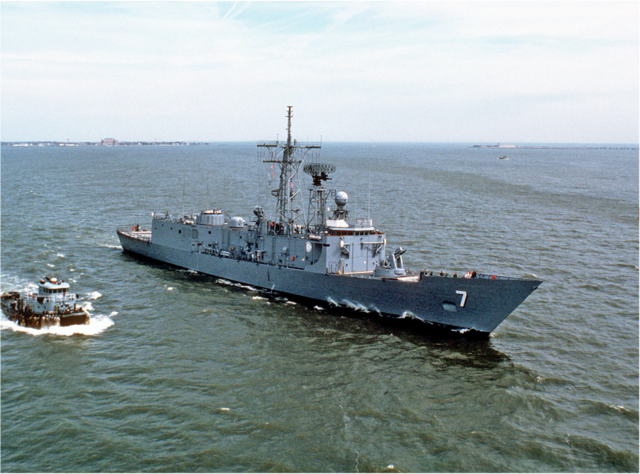Admission CTAs
Mason Develops Computational Tools to Optimize Ship Design and Train Naval Architects
Dr. Chi Yang, a professor of computational fluid dynamics in the physics and astronomy department at George Mason University, leads a research group that has developed a computational tool, SimDShip, to accomplish innovative, simulation-based design of ship hull forms.
By enabling hydrodynamic optimization at early stages of ship design, SimDShip allows researchers to efficiently explore and evaluate a wide range of novel hull forms, ultimately shortening the design cycle and saving fuel consumption costs. Designing ships with high energy efficiency is economically desirable because ships that require less power consume less fuel, or they can sail at a faster operating speed with the same fuel consumption.
With its development funded by a three-year, $600,000 grant from the U.S. Office of Naval Research (ONR), SimDShip will be incorporated into the Integrated Hydrodynamics Design Environment (IHDE) within the U.S. Navy’s CREATE-Ships Project. The current suite of computational tools builds upon methods and algorithms Yang’s group developed under a previous five-year, $800,000 ONR grant.
Yang’s research has also been supported by the Atlantic Center for the Innovative Design and Control of Small Ships (ACCeSS), a university/industry consortium, established by the ONR in 2002 to support naval engineering programs nationwide and their international collaborators. Yang was invited to join ACCeSS in 2012 to represent Mason and contribute expertise in computational tool development, and she served as one of the consortium’s co-PIs from 2015 to 2018. Through ACCeSS, Yang’s research group worked with experimental collaborators at various universities—including the Stevens Institute of Technology, the U.S. Naval Academy, Florida Atlantic University, and Webb Institute—to validate SimDShip and improve its capabilities.
The team has benefited immensely from the ACCeSS collaborations.
“ACCeSS helped us connect with experimental researchers to validate the computational tools we were developing, offering a unique opportunity, as academic researchers, to learn about the design needs of the Navy and industry partners,” said Yang.
Through receiving input and feedback from different institutions, the team was able to create projects that could be used to not only validate computational tools, but also teach student trainees how to design and carry out experiments that synergize with computational needs.
Internships for future naval architects
As a member of ACCeSS, Dr. Yang worked closely with researchers at the Center for Innovation in Ship Design (CISD) at the Naval Surface Warfare Center–Carderock Division (NSWCCD). She spent three summers at CISD as an ONR Senior Summer Faculty Fellow, where she led teams of interns sponsored by the Naval Research Enterprise Internship Program (NREIP) to further develop the computational tools that ultimately contributed to SimDShip.
In addition, Yang’s research group worked with CISD interns to validate optimal hull forms. Notably, her group identified FFG7, the lead ship of the USS Oliver Hazard Perry class of guided-missile frigates, as a prime candidate for further optimization and confirmed that the ship’s power requirement could be reduced by 7% by adding a bulbous bow and a stern-end bulb. The CISD NREIP interns were then able to validate these findings by performing model tests at the U.S. Naval Academy.
Yang, a part of Mason’s Computational and Fluid Dynamics Center, also works closely with NSWCCD’s tool development group, through which she interacts with junior engineers to introduce them to simulation-based design and academic research. Some of these engineers have now decided to pursue their PhDs at Mason; one of them, Austin Shaeffer, is now a PhD candidate advised by Yang. He is currently working part-time at NSWCCD on a project in which he both contributes to and leverages SimDShip’s capabilities. The results of this project will be part of his dissertation.
“SimDShip was designed with educating the next generation of naval architects in mind,” said Fernando Miralles-Wilhelm, dean of Mason’s College of Science. “We collaborate with our partners to find innovative solutions to today’s problems while simultaneously developing pathways to train the military workforce of the future,” Miralles-Wilhelm said describing this suite of computational tools that provides an interactive, user-friendly simulation environment for various skill levels.
In fact, two recent Webb Institute graduates were able to use SimDShip to develop and validate a novel bulbous bow yacht design for their senior thesis. Their successful employment of SimDShip demonstrates that these tools can be easily learned and broadly useful for hydrodynamic optimization of hull forms.
Yang looks forward to continuing to expand the toolkits available for researchers. She sees great potential in working with the U.S. Navy to develop more tools and educate more trainees, with the goal of helping the next generation of naval architects tackle the challenges of tomorrow.
“Imagine if you were studying a thousand unique hull forms—how expensive would it be if you had to build and set up detailed experiments to test each of them?” Yang said. “Instead, by learning to harness the power of simulation, we can shrink the design space and turn our attention to innovating solutions in new areas, whether that’s building more efficient unmanned vehicles or greener ships.”


